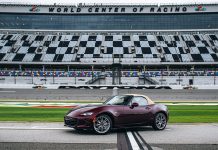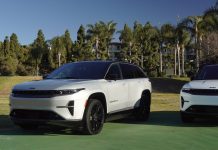This midsize crossover EV has a lot more competition than when it debuted in 2021.
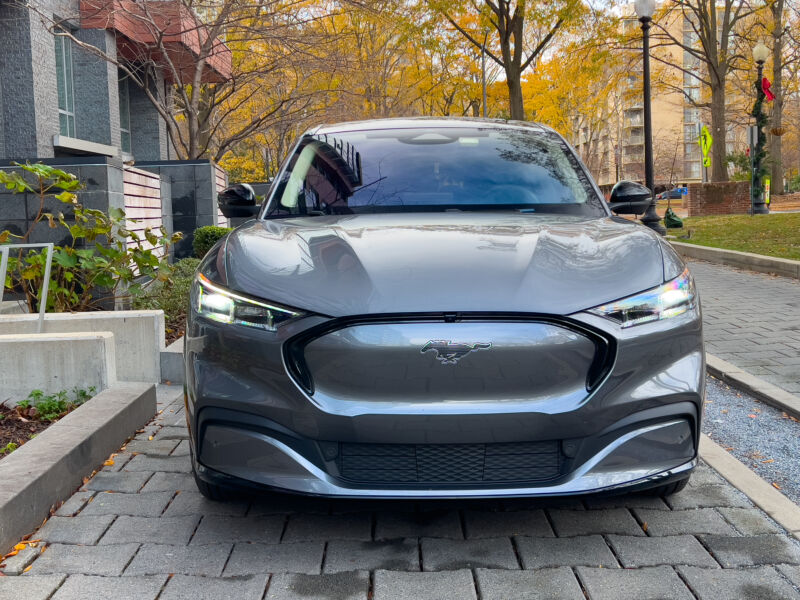
When Ars first drove the then-new Ford Mustang Mach-E back in early 2021, the car was an attention magnet. Now, almost three years later, the Mustang Mach-E is a much more common sight on our roads, but so are other electric crossovers from most of Ford’s usual rivals, including the sales juggernaut that is the Tesla Model Y. We decided to book a few days with a Mustang Mach-E to see how (or if) this equine EV has matured since launch.
Originally, Ford had been working on a much more boring battery electric car until Tesla started delivering its Model 3s, at which point a hastily convened “Team Edison” set to work adding some much-needed brio to the design, rethinking Ford’s EV strategy in the process.
Giving this midsize crossover EV a Mustang name tag remains divisive—I expect a reasonable percentage of comments to this story will be people showing up to complain, “It ain’t no real Mustang.” The crossover’s name is what it is, and there are plenty of Mustang styling cues, but even with the designers’ trick of using black trim to make you ignore the bits they don’t want you to see, there’s no denying the proportions are pretty far from coupe-like.
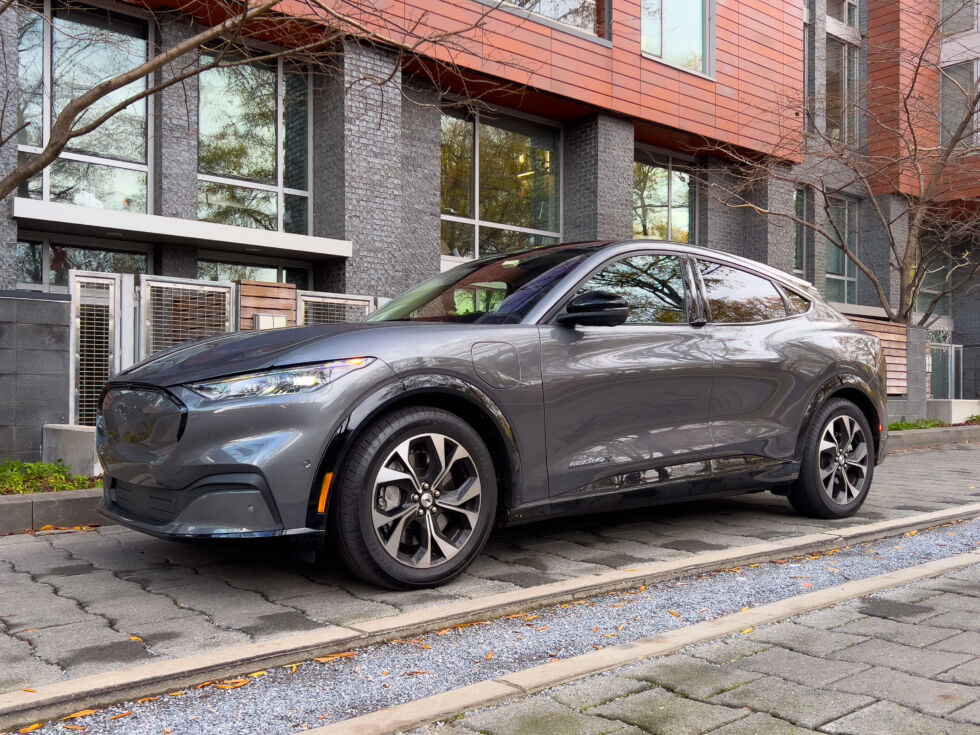
It’s cheaper now
Our test car was a Mustang Mach-E Premium eAWD model with just a single option ticked, the 91 kWh (useable capacity) extended range battery. This increases the car’s EPA range estimate from 224 miles (360 km) to 290 miles (467 km) but costs $8,600, which, combined with the delivery charge, bumps the sticker price to $67,575.
At least, that’s what this Mustang Mach-E cost when it arrived on the press fleet some 5,500 miles ago. Ford had to respond to Tesla’s string of price cuts, dropping the MSRP by almost $7,000 and cutting the cost of the extended range battery to $7,000—when I configure the same spec on Ford’s online car builder, it tells me the total price should be $59,940 with all the various fees. (A further price cut came to most other Mustang Mach-E variants in May, but not for the extended range Premium eAWD.)
And until the end of this year, the EV is still eligible for half of the clean vehicle tax credit. However, Ford believes that $3,750 credit will no longer be available to Mach-E buyers from next year as new rules regarding batteries made by “foreign entities of concern” go into effect. These remove eligibility from EVs batteries made in China or by Chinese-owned companies from January 1, 2024.
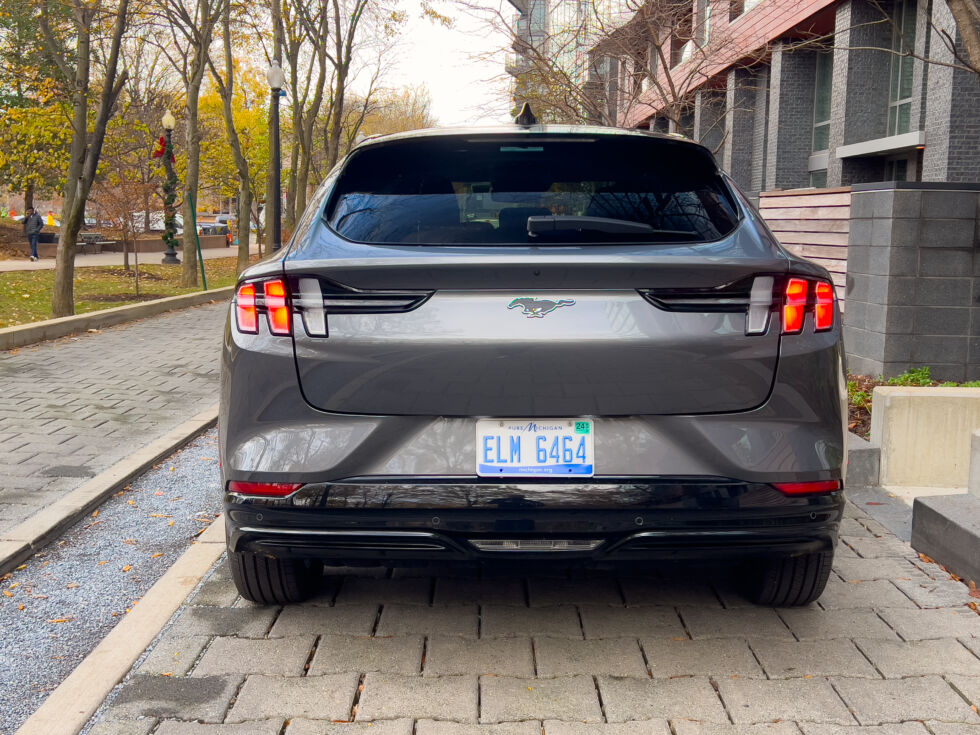
It’s a hard life
The fact that the Mustang Mach-E’s trip computer hadn’t been reset in 3,572 miles (5,749 km) provides an illustrating insight into both the life of a press fleet vehicle as well as the long-term efficiency of this EV. Collectively, the car had been driven very unsympathetically over that time, grading the drivers at 1 percent for deceleration and 2 percent for both acceleration and speed. Despite the lead foot treatment, the average of 2.7 miles/kWh (23 kWh/100 km) matches the EPA efficiency estimate (expressed as 37 kWh/100 miles).
I’m guessing this particular car spent most of those miles in Unbridled, which is what the Mustang Mach-E calls its sport mode. That or Engage, which is the middle of the three settings and the one used to calculate the car’s official efficiency.
In Whisper (think eco mode), you don’t get quite all the 346 hp (258 kW) or the full 428 lb-ft (580 Nm), and the 0–60 time feels between a second or two slower than the 4.8 seconds that’s possible if all the electric horses are harnessed at the same time, at least 3.1 miles/kWh (20 kWh/100 km) should be possible.
Easy to charge
Fast-charging the Mustang Mach-E was also painless. The Ford now features plug-and-charge, meaning that as long as the fast charger does too, all you need to do is plug it in, and the car will take care of billing during the handshake process.
- This press car has been driven with lead feet for the past few thousand miles. Jonathan Gitlin
- I definitely give the Ford props for ease of charging.
- As soon as the battery hit 80 percent state of charge the rate of power dropped, but I stayed connected for a few more seconds as I couldn’t leave it at 59.98x kWh, it had to tick over to 60. Jonathan Gitlin
- I suspect my drive home from the fast charger involves a little decrease in elevation, as that was the only time I saw close to 4 miles/kWh. Jonathan Gitlin
Arriving at a fast charger with a 17 percent state of charge (with the charger set in the onboard navigation as the destination, which tells the car to begin preconditioning the battery), it took 37 minutes to reach 80 percent SoC, at which point the charger began to throttle back to a lower power rate. Compared to other fast-charging experiences this year, this was the least painful. With an 80 percent charge, the dash reported we had 203 miles (326 km) of range.
Needs more driver engagement
Regardless of the drive mode, I still fail to find the Mustang Mach-E much fun on the road. Having grown up driving Fords from the era when the late Richard Parry-Jones had the final say in how they handled, I expect more from a car wearing the blue oval badge. The steering doesn’t offer much in the way of feedback, and the suspension isn’t particularly supple, presumably due to a need to control this EV’s 4,838-lb (2,194 kg) curb weight. Another reason to just keep it in Whisper mode, I guess. (And it’s not like there haven’t been uninspiring gasoline-powered Mustangs, but still.)
Ford will sell you an actually sporty Mustang Mach-E, the Mustang Mach-E GT, which is a few thousand dollars cheaper than when we drove it in late 2021, although you need to pay for the optional magnetorheological dampers, too. Or wait until next year when the Mustang Mach-E Rally reaches the showroom. We’re yet to drive that variant, but a combination of tires with bigger sidewalls and a slightly higher ride height together with the magnetic dampers sounds very intriguing.

Does well with the mundane stuff
A lack of driver engagement doesn’t mean it’s bad at the day-to-day stuff. Visibility is mostly good, the steering weight isn’t heavy, and there’s a one-pedal driving mode for those who partake. And I like the interior design, with the major caveat that Ford’s design team was seduced by Tesla’s touchscreen-only approach to Human Machine Interfaces. All the Mustang Mach-E’s controls are accessed through the big 15.1-inch infotainment screen, which is a subpar way of having to turn on your seat heater. Both Apple CarPlay and Android Auto work wirelessly, and if you use Apple Maps on your iPhone (but not Google Maps), it will send turn-by-turn directions to the main instrument panel in front of the driver.Advertisement
Bluecruise is another feature not implemented in the Mustang Mach-E at launch. It’s Ford’s “level 2+” driver assist, which means you can take your hands off the wheel when it’s engaged, but you’re still responsible if you hit anything. Unlike the similar Super Cruise (GM’s offering), Bluecruise engages automatically if you’re using adaptive cruise control and on one of the stretches of pre-mapped highway.
When in Bluecruise, the UI on the main instrument panel in front of the driver changes so there’s no ambiguity or mode confusion. And both Bluecruise and the “keep your hands on the wheel” regular adaptive cruise control and lane-keeping combo can do lane changes for you, initiated by using your turn signal.
- Bluecruise changes the dash to all-blue when it’s active. Jonathan Gitlin
- The seats could offer a little more lateral support. Jonathan Gitlin
- The rear is pretty spacious. Jonathan Gitlin
- Ford’s solution to avoid having draggy door handles is better than the ones that lie flush and then pop out. Jonathan Gitlin
- More than enough space for a Costco run. Jonathan Gitlin
- The Mach-E has a frunk, but click to the next image to see its fatal flaw. Jonathan Gitlin
- You can only open the frunk via this lever, like the hood on a conventional car. Which makes it a lot less useful if you had a bunch of groceries you wanted to put in there quickly. Jonathan Gitlin
As noted at the beginning, the Mustang Mach-E now faces much more competition than it did in 2021.
Tesla’s Model Y is cheaper, will go further on a charge, and is far and away the segment leader in terms of sales, although buying a Tesla in 2023 is a step too far for some, given its CEO’s recent behavior. Like the Tesla, the VW ID.4 is eligible for the full $7,500 tax credit, and manages to be a little more involving to drive while also being handicapped by some poor choices in terms of HMI, plus a cabin that can feel quite spartan.
Arch-rival Chevrolet has just started building Blazer EVs to compete with this Ford—you can read our take on that car on December 13. I’d consider a Nissan Ariya, were I cross-shopping, but the best midsize electric crossovers, as far as Ars is concerned, are still the Korean E-GMP twins, the Hyundai Ioniq 5 and Kia EV6.

